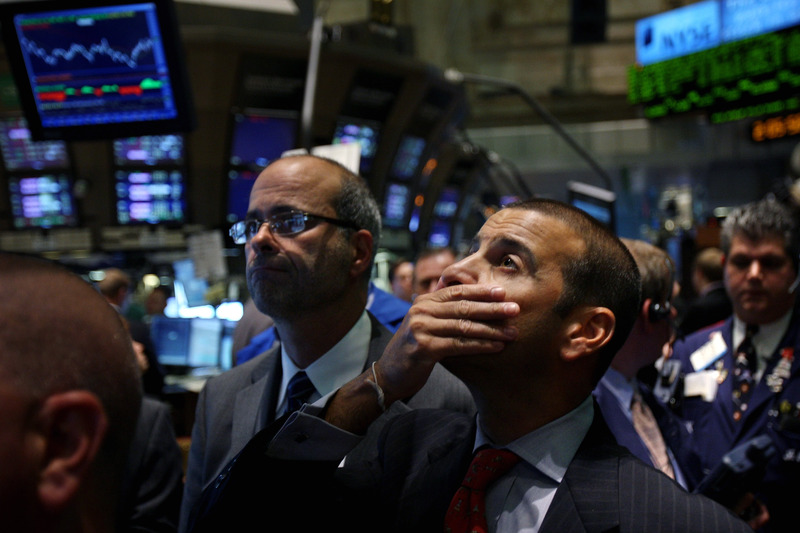Investing
Eight Serious Market Indicators to Watch During This Correction
Published:
Last Updated:
Any time a market peaks, investors and commentators talk about the expectations of a sell-off. The S&P 500 and Dow Jones Industrial Average peaked less than two weeks ago. Now the accelerated stock market selling has investors worried. If you just listened to the financial media you might think that the sky was about to fall.
24/7 Wall St. wanted to alert its readers to several key indicators to watch. The good news is that none of these signal serious or grave concerns for the broader markets in unison. The bad news is that if half of these key issues to watch grow beyond the threshold levels, then there will be too many items occurring simultaneously to ignore.
These are not in any set or specific order because we all have our own “most important” indicator. Currencies have been left out as they are often too headline driven — just don’t forget that the currency markets influence commodities heavily and they are the largest of all global markets.
10-Year Treasury. The yield on the 10-year Treasury note is key to watch. On Tuesday the 10-year broke under 2.60%. Most economists were expecting that rates would have already risen by now, perhaps to above 3% or even 3.5%. This is a flight to quality, and if bond yields get too low it is a sign that investors will be accepting a return of capital mentality rather than demanding a return on capital. If the 10-year moves back under 2.50% then it means the worry factor is getting high.
Russia and Ukraine. The news headline from Ukraine military strikes and Russian supporters caused a spook, and Putin is unlikely to give up on his ambitions if he can justify it. We will not keep a keen eye on any specific stock or bond levels in Russia, but don’t discount this. It is very possible that equity markets in Europe and the United States are not worried about this enough.
Gold Prices. With fears of escalating warfare in Ukraine growing again, the stage is set for gold. Oddly enough, gold is not rallying, in part due to weaker Asian demand. Gold even went back under $1,300 per ounce on Tuesday. If gold keeps tanking, it can create the same sort of market concerns as if it was rising too much. If gold sells off into pressure, then the talk of $1,000 gold will come back up.
Oil, Black Gold. NYMEX Crude was recently at $103 and has been challenging highs from a month ago. If oil hangs above $100 for too long, it will spell another fear of less consumer spending. That may seem unlikely, but there is an ongoing debate on what should be happening to the price of oil.
Alternative Energy. Rising energy prices have helped the renewable energy shares flourish, up until recently. A recent UN report on climate change was also much more of a concern than some were hoping for. The PowerShares WilderHill Clean Energy (NYSEMKT: PBW) is the key exchange traded funds (ETFs) for this sector, and its drop to $6.40 is officially down 20% from the $8.02 peak on March 11 and down from $7 just last Thursday.
Market Volatility — The VIX. The CBOE VOLATILITY S&P 500 rose more than 6% Tuesday afternoon to 17.18, after hanging below 13 and 14 for a long time. For the market to get truly oversold for a good technical bounce, that VIX reading likely needs to start getting closer to 20 before it means that weak holders have been shaken out. That being said, there is also no reason that the VIX could not keep rising either.
Momentum Stocks. The first indicator to watch is the momentum arena on Nasdaq. Of the Nasdaq 100 components, more than 70% are now appearing to be more than 10% off their highs. With Tuesday’s selling, one-fourth of these are down by 20%. The Nasdaq keeps wanting to break back under the 4,000 mark. As far as the Nasdaq 100, the PowerShares QQQ (NASDAQ: QQQ) is close to a critical point. At $83.60, it is down from a recent peak of $91.36, and the 200-day moving average is down only about $1.50 lower — at $82.08 as of Tuesday.
Biotech. This was the most loved sector outside of hot social media IPOs in the bull market. You can watch iShares Nasdaq Biotechnology (NASDAQ: IBB) for the Nasdaq as it tracks the key biotech sector. This broke under the key 200-day moving average three days ago, and the last test like this was in late 2012. The difference this time around is that the ETF has doubled since then prior to this last selling wave. The IBB is $10 under the 200-day moving average now that it is below $210 per share. If this continues south, it will likely create additional dragging of others.
Are there more things to consider? As they would say in Fargo, you betcha!
Thank you for reading! Have some feedback for us?
Contact the 24/7 Wall St. editorial team.